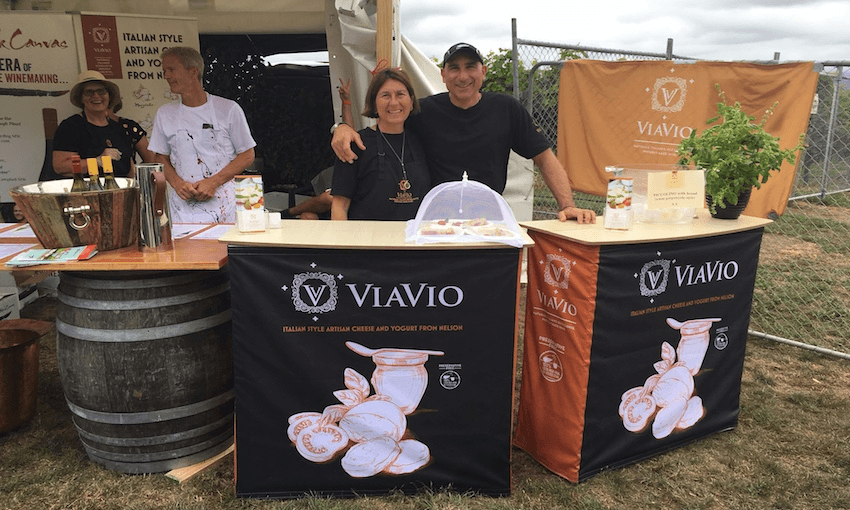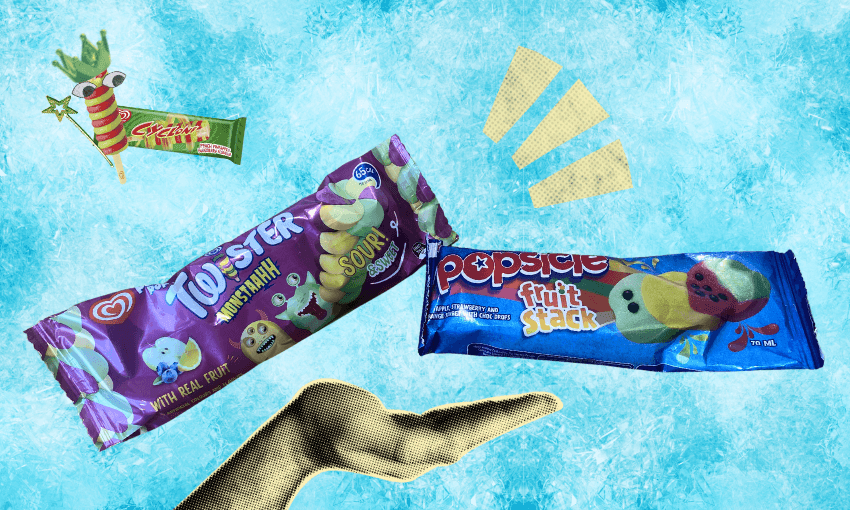In the third part of a series in which The Spinoff gets to know who, what, where and how our food gets to our plate, Alice Neville learns about what goes into making mozzarella, ricotta, gorgonzola and more.
The bright lights and smooth floors of the supermarket are a world away from the soil and sun, the plants, animals and humans which have toiled to create the food that arrives on the shelves. Most of us shopping in those shiny supermarkets have lost touch with where our food comes from and the people responsible for making it. Few of us know the chicken farmers or cheese makers or avocado growers who work to fill the supermarket, or how they produce the food we eat.
This disconnection from our food has created an array of modern problems that affect our health, our environment and our society. Because we don’t understand the effort and energy involved in producing food it’s hard to appreciate its worth. As a result, far too much valuable food ends up in the landfill. This lack of understanding about the origins of our food has created a world where unethical and environmentally suspect farming practices have thrived. And it means brilliant local food producers have struggled to survive, as consumers choose the cheapest, easiest option.
So, in partnership with New World, The Spinoff is getting to know the food that lands on the shelves of our supermarkets a bit better. We’re speaking to the people responsible for producing some of New Zealand’s beautiful local food about how it’s produced, where it comes from, and what makes it unique.
In part three, we learn about the Italian cheeses made by ViaVio.
Read part one on the world-class fruit produced by 45 South cherries in Central Otago, and part two on the extra virgin olive oil made by The Village Press.
Italian couple Flavia Spena and Flavio Donati have long had a soft spot for Aotearoa. They’d visited many times over the years through Donati’s career as a professional rugby player, but though they loved it here, they always missed the deliciously unique Italian cheeses they enjoyed at home.
In 2016, the pair took the leap and swapped Rome for sunny Nelson, with Spena leaving her high-flying job as an executive for Bulgari, where she’d been for 25 years. It was time for a change of pace, so they founded ViaVio (the name comes from the last three letters of each of their names), and set about bringing traditional Italian cheeses to the people of New Zealand. They’ve already made their mark, taking home five medals in the 2019 NZ Champions of Cheese Awards as well as being honoured in 2018’s Inspire+ NZ Artisan Awards. Here, Flavia Spena shares their story.
How did you end up in New Zealand?
We had a very tight link with New Zealand because my husband used to play rugby professionally and he played with some top New Zealand players. So we had come to New Zealand many times and we liked the country.
As Italians, we like good food, and we noticed there was a limited variety of cheese here, especially Italian-style cheese. I was working very hard – I was a top executive of a multinational company in Italy for 25 years – so we decided to change our lifestyle and come to New Zealand and make cheese. We wanted to combine the top-quality milk that New Zealand has with traditional skills and knowledge from Italy, so we brought a cheesemaker with extreme passion for cheesemaking and 20 years of experience over from Italy.
Why was it necessary to get an Italian cheesemaker?
New Zealand is a very young country in terms of making cheese, and we felt to stay true to Italian traditions we needed someone with the necessary years of experience to make these particular types of cheeses. We make cheeses that are so different – even in Italy, there are people who specialise in specific cheeses and not others. In Italy, we have more than 1000 different types of cheese.
Was it hard to find someone with the right experience who was willing to move to New Zealand?
Yes, definitely, because there is high demand for cheesemakers in Italy. Cheesemakers can find everything they want in Italy, so we needed to find someone who is more adventurous, and who liked the idea of living abroad. It’s not easy to find a good, skilled cheesemaker who wanted to move. We are fortunate to have found the right person, we’re very happy. He’s extremely talented – he’s been making cheese for more than 20 years in Italy and he’s enjoying the adventure of making cheese in New Zealand. You need a person who is passionate about being with us and sees it as a long-term venture.
Why did you choose Nelson?
Firstly, it’s a nice place to be and has very good weather, then more importantly because we found the right farmer to provide us with the milk. It was very important to us that we knew the farmer and farm practices, to ensure we were getting the very best quality product. All our cheese and yoghurt is made from milk from local farm Oaklands, whose milk comes from A2-tested cows.
What sort of cheese do you make?
We make some cheeses that everybody knows, like mozzarella, but we also have some cheeses that people are less familiar with, like stracchino, for instance, and fontal. Not so many people in New Zealand know these styles, but when they have the opportunity to try them, they really enjoy them. The cheeses we produce are very popular in Italy – we eat cheese in Italy every day with a meal, whereas here people tend to use it mainly on a cheeseboard. We’re the best of both worlds for cheese lovers; we take the best New Zealand dairy and apply Italian cheesemaking techniques.
And you do a yoghurt too?
Yes, we make it to the same traditional recipe that they use in Italy, in the Dolomites. We sell the yoghurt in a glass jar like we do it in Italy. It’s a beautiful yoghurt – we always say that it’s the best yoghurt in New Zealand. Even people who usually don’t like yoghurt seem to like ours. There’s no added sugar but it’s naturally sweet because the milk is good. We are passionate about what we’re doing, so we make it simple but top quality.
What’s the most difficult cheese to make?
Gorgonzola is very sensitive to any differences in the milk. When working with natural milk, depending on the phase of lactation the cows are in, the milk can be very different in terms of fat and protein. In particular, gorgonzola is the most reactive cheese to these natural changes. The cheesemaker makes holes in the cheese into which oxygen flows to allow the mould to develop. This can be affected by differing fats and proteins, which cause the holes to close up and prevent the blue veins being visible (although the flavour will still be the same). You need a very experienced cheesemaker to read these natural challenges and balance all the variations. We really like our gorgonzola, but it’s a challenge to make!
What’s your best-selling product?
The mozzarella and bocconcini (small balls of mozzarella), because they’re the products that people know the most. With others, like stracchino, they might not recognise the name, but once people try it, they like it so much. It has a yoghurty taste that matches so well with smoked salmon and vegetables. When they first find it on the shelf without knowing the name, some people are hesitant to buy it because they don’t know what to do with it. So, educating people about the simplicity of how to use our cheeses is key to encouraging those first-time purchases.
It’s the same with ricotta – we make it in the traditional way with just whey and salt. It’s still soft and light and low fat. People tend to think that ricotta is a sort of spread, so when they try it they’re very surprised about what they’re eating. We eat fresh ricotta with honey for breakfast every day in Italy.
What’s your favourite?
I like the ricotta a lot, and then we make an aged hard cheese, a washed rind called fontal. It is so good. In Italy, it comes from the mountains and they use it for cheese fondue.
What are the biggest challenges you face as a business?
People getting to know us, and knowing what to do with the cheeses we make. We are doing a lot of education and tastings – we try to explain to people how to use ViaVio cheese as a meal, with good, natural ingredients.
Do you think New Zealanders are open-minded about trying new cheeses?
Very much. A lot of New Zealanders travel and try food all over the world. We find New Zealanders very open to new products, but of course, if you grew up with only hard cheddar-style cheese and had never tried soft mozzarella, you would think it had a very different texture and flavour. You also need to understand how to use it. But definitely, we find people are very open-minded and they like good-quality products.
This article was created in paid partnership with New World. Learn more about our partnerships here.






